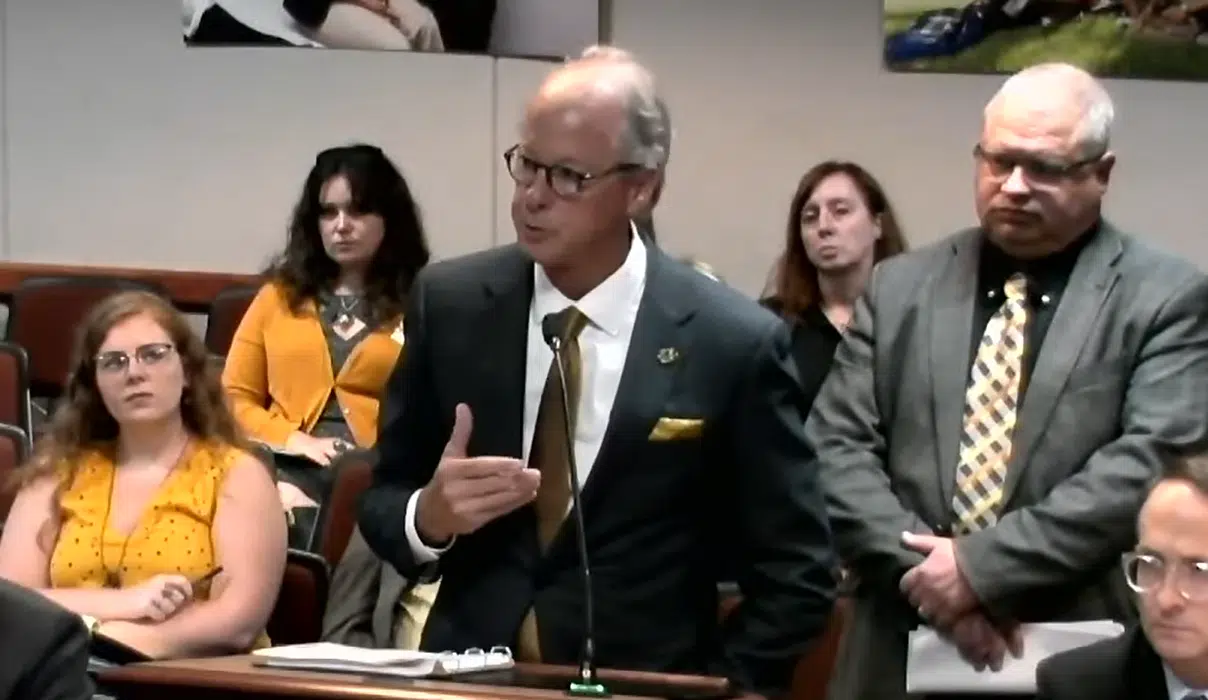Emporia State University’s Workforce Management Framework Policy has been given the blessing of the Kansas Board of Regents.
Regents members voted unanimously to approve the framework as part of their regular meeting Wednesday afternoon. The decision came following comments from ESU President Ken Hush and Interim Provost Brent Thomas.
Thomas says the framework will grant the university the “latitude and expediency” needed to set the university up for long-term success.
The policy gives the administration the leeway to “suspend, dismiss or terminate any university employee” for several stated factors, including low enrollment, operations costs, revenue reductions, resource realignment, performance evaluations, teaching and research productivity and low service productivity, but it also indicates this is not the complete list and the full list of termination reasons is not stated.
Neither Thomas nor Hush have detailed any programs that may be up for consideration, however, Hush stated any decisions are the result of an extensive “academic review process.”
Furthermore, Thomas stated the leadership team tasked with overseeing the review had input from individuals representing all areas of the ESU campus.
President Hush has said the ESU framework is needed to because of a notable decline in on-campus enrollment and a lower-level decline in overall enrollment the past five years, as well as ongoing negative financial effects of COVID-19 and a need to update class offerings that reflect the university’s “strike zone.” The Faculty Senate strongly disagrees, saying the framework is nothing more than a way to end tenure, either on a temporary or permanent basis.
Wednesday morning, about 50 Emporia State students gathered in front of Plumb Hall on Wednesday to protest the potential decision. Organizer Sean Singer, a history and law student from Edgerton, says the loss of tenure for professors is a loss for students and the community as a whole. And he says this runs counter to Hush’s stated goal of being student-focused and student-driven.
Singer says other Kansas universities are watching the situation at ESU and are poised to make their own cuts if this is passed.
In cases of suspension, dismissal or termination, President Ken Hush shall provide at least 30 days written notice, including reasons for the action being taken. Affected employees can then appeal through the Board of Regents office within 30 days, followed by another 30-day window for Hush to respond and a 10-day window for the matter to be referred to the KBOR Office of Administrative Hearings.
Employees have the burden of proof, according to the policy. Those who win their appeals will be entitled to reinstatement, back pay and restoration of other lost benefits.
11:16 am Wednesday: Emporia State students protesting university’s Framework for Workforce Management up for KBOR vote Wednesday
The Kansas Board of Regents is set to vote on Emporia State University’s Framework for Workforce Management on Wednesday afternoon.
The agenda item is first up for the Regents after a series of committee and council reports and should start around 3 pm. President Ken Hush has said the ESU framework is needed to because of a notable decline in on-campus enrollment and a lower-level decline in overall enrollment the past five years, as well as ongoing negative financial effects of COVID-19 and a need to update class offerings that reflect the university’s “strike zone.”
The Faculty Senate strongly disagrees, saying the framework is nothing more than a way to end tenure, either on a temporary or permanent basis. And about 50 Emporia State students gathered in front of Plumb Hall on Wednesday to protest the potential decision.
Organizer Sean Singer, a history and law student from Edgerton, says the loss of tenure for professors is a loss for students and the community as a whole.
Singer says other Kansas universities are watching the situation at ESU and are poised to make their own cuts if this is passed.
The policy, posted below, gives the administration the leeway to “suspend, dismiss or terminate any university employee” for several stated factors, includnig low enrollment, operations costs, revenue reductions, resource realignment, performance evaluations, teaching and research productivity and low service productivity, but it also indicates this is not the complete list and the full list of termination reasons is not stated.
In cases of suspension, dismissal or termination, President Ken Hush shall provide at least 30 days written notice, including reasons for the action being taken. Affected employees can then appeal through the Board of Regents office within 30 days, followed by another 30-day window for Hush to respond and a 10-day window for the matter to be referred to the KBOR Office of Administrative Hearings.
Employees have the burden of proof, according to the policy. Those who win their appeals will be entitled to reinstatement, back pay and restoration of other lost benefits.
The ESU decision is based on the Regents’ Workforce Management Policy, which was initially enacted as a COVID-19-based option for universities in January 2021 and was extended earlier this year to stay in place through New Year’s Eve.
We’ll have updates from the Board of Regents meeting Wednesday on KVOE, KVOE.com and KVOE social media.
EMPORIA STATE UNIVERSITY FRAMEWORK FOR WORKFORCE MANAGEMENT
Rationale for why the Framework must be implemented. Pursuant to the Board of Regent’s policy set out at Chapter II, Section C., Paragraph 6.b., “In light of the extreme financial pressures placed on the state universities due to the COVID-19 pandemic, decreased program and university enrollment, and state fiscal issues, effective immediately through December 31, 2022 and notwithstanding any other Board or institutional policy, any state university employee, including a tenured faculty member, may be suspended, dismissed, or terminated from employment by their respective university. Such terminations, suspensions, or dismissals shall follow the procedure set forth below. Declaration of financial exigency and the processes associated with the declaration of financial exigency shall not be a prerequisite to any suspension, dismissal, or termination authorized by this provision, and no existing university policy hearing procedures shall apply to
such decisions.”
Emporia State University, which is committed to being forward focused and future ready, is placing the needs and expectations of its current and future students at the center of its strategic efforts. Ongoing changes in industry demands, locally and nationally, as well as changes in student demographics and commitments to higher education affect the historical mission of ESU. The University’s primary sources of revenue are student tuition and taxpayer dollars provided through the legislature. Increases in student tuition revenue are dependent on increased enrollment, which is very difficult to achieve for any university during these times. Because ESU has experienced extreme financial pressures accelerated by the COVID-19 pandemic, decreased program and university enrollment, and state fiscal issues, the University continues to face increases in the cost of operations across campus as well as substantive changes in the educational marketplace. These increased costs include higher costs being charged by providers and suppliers, as well as the necessity to properly maintain and support facilities, equipment, systems, security, and personnel. While the University is not facing financial exigency, the financial and market situations do require a prudent review and restructuring, which will require modification, reorganization, suspension, or elimination of certain operations, programs and curriculum, which may require immediate action notwithstanding any other Board or institutional policy. This framework allows for a more
orderly transition to what is best for the University.
The Framework:
A decision to suspend, dismiss, or terminate any university employee shall be based on factors such as, but not limited to:
• Low enrollment.
• Cost of operations.
• Reduction in revenues for specific departments or schools.
• Current or future market considerations as to the need for a program or department.
• Restructuring of a program, department, or school as determined to be necessary by the
university.
• Realignment of resources.
• Performance evaluations.
• Teaching and research productivity.
• Low service productivity.
A decision for action must be made in consideration of the following:
• Relevant accreditation requirements for the program, school, or college.
• Course availability to students in order to complete degree requirements. Course availability means students can take necessary courses either at ESU or through another university or community college in Kansas.
The procedure to be followed for taking action, pursuant to Board policy, is described below:
1. Notice. The President shall provide no less than 30 days’ written notice of suspension, dismissal, or termination to the affected employee. This notice shall include a statement that this action is being taken pursuant to this policy, the reasons for the action being taken, the effective date of the action, and shall also include any considerations to be provided by
the University to the affected employee (such as severance pay, payouts, retirement options, etc.).
2. Appeal. The employee may appeal the action taken pursuant to this policy through the Board of Regents office to the Office of Administrative Hearings. Any action taken that is not being taken pursuant to this policy shall have solely those appeal rights provided by existing university policy or other applicable procedures.
3. Appeal, Time and Content of. The employee must submit an appeal to the Board office within 30 days of receiving notice of the action. The appeal must include a copy of notice of the action received by the employee and a written statement with any relevant supporting evidence describing why the employee believes the decision for the action: (a) is substantially inconsistent with the university’s decision-making framework approved by the Board; (b) was the result of unlawful bias or discrimination; or (c) was otherwise unreasonable, arbitrary or capricious. These are the only grounds for reversing the
President’s decision. The employee shall provide a copy of their appeal documents to the President at the same time they are submitted to the Board office.
4. Response to Appeal by President. The President shall have 30 days from receipt of the appeal to respond in writing to the appeal. This response shall include any supporting evidence or documentation. This response with supporting evidence or documentation shall be sent to the Board office with a copy sent to the employee at the same time. This 30 day period can be extended for good cause as determined by the Board President and CEO.
5. Submission of Appeal to Office of Administrative Hearings. Within 10 days of receiving the President’s response to the appeal, the Board office shall refer the appeal to the Office of Administrative Hearings. The Office of Administrative Hearings shall provide a hearing and decide the appeal based on the standards stated in the Board’s policy and in the
University’s framework approved by the Board. The University shall be responsible for fees charged by the Office of Administrative Hearings.
6. Hearing before the Office of Administrative Hearings. The burden of proof is on the employee. No discovery will be permitted. The review shall be based on the written materials submitted, along with any oral presentation to the administrative hearing officer by the employee and the University. The employee and the University may be represented
by counsel.
7. Decision. The decision of the administrative hearing officer is final and not subject to further administrative review by any officer or committee of the university or by the Board of Regents.
8. Action Not Stayed during Appeal. An appeal under this policy will not stay the effective date of the suspension, dismissal, or termination. An employee who wins their appeal will be entitled to reinstatement, back pay and restoration of other lost benefits.






















